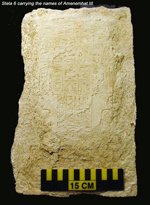The most ancient mariner
Archaeological find may point the way to lost land of Punt

Kathryn Bard has made some fascinating archaeological discoveries in Africa over the years. But, says the College of Arts and Sciences associate professor of archaeology, none of them can top her latest: the oldest remains of seafaring ships in the world, along with relics from the lost land of Punt.
In December and January, she and her research team, codirected by Bard and Italian archaeologist Rodolfo Fattovich of the University of Naples L’Orientale, were exploring an excavation at Wadi Gawasis on Egypt’s Red Sea coast when they unearthed 4,000-year-old cedar planks and decking timber — some with mortises and tenons, and copper fastenings, still in place. On February 28 Bard and Fattovich discussed their findings at a lecture for the New England chapter of the nonprofit American Research Center in Egypt, which supports research on Egyptian history and culture, at the School of Education.
The ship’s parts and cargo were found in man-made caves that had been discovered during an excavation in December 2004. “When we were there the last time,” says Bard, “we uncovered entrances to two caves, and we thought it was a shrine. But we now know it’s much more extensive. There are five parallel rooms cut into the rock, and they were all used as a ship arsenal.”
Bard’s discovery, which includes more than 20 wooden cargo boxes believed to come from the lost land of Punt, provides persuasive evidence that Egyptians traveled great distances by sea. “Most scholars think that they traveled far by land for trade,” says Bard. “But there isn’t much evidence of seafaring trade to Punt.”
The remains may help researchers determine the exact whereabouts of Punt, a mysterious land that historians have variously placed in Sudan, Eritrea, Yemen, or Somalia. The trading destination, also known as God’s land or the Red Land because of its red soil, was prized by ancient Egyptians for its gums and resins, which were used for incense and ointments. Egyptian traders returned from trips to Punt with ebony, ivory, and gold from the kingdom as well. For her part, Bard believes that Punt was about 800 miles south of her excavation, near what is today Kassala, a city in eastern Sudan.
One of the cargo boxes has a hieroglyphic inscription with a royal cartouche painted on it — of a king believed to be Pharaoh Nimaatra Amenemhat III (1831–1786 BC). “The hieroglyphs describe the contents of the box as ‘The wonderful things of Punt,’ ” says Bard.
Inside one of the rooms in the caves Bard found 60 to 80 coils of ship rope, “all neatly tied and knotted, just as sailors left them almost 4,000 years ago,” she says. Other artifacts include pieces of pottery, a large stone anchor, a limestone tablet, or stela, of Amenemhat III inscribed with all five of his royal names, as well as pieces of pine and oak, all from southwest Asia, along with wood from the Nile Valley.
During the previous excavation the team found many other nautical items, including two cedar steering oars that the scientists speculate were used on 70-foot-long ships from Egyptian Queen Hatshepsut’s well-documented 15th-century BC voyage to Punt.
“This was the most famous seafaring expedition to Punt,” says Bard. “It’s described on her mortuary temple at Deir el-Bahari in Thebes.”
Nearby, they found a stela with more hieroglyphic inscriptions detailing trade expeditions to the legendary land.
While such finds are thrilling, according to Bard, the work can also be dangerous. The partially collapsed caves “have big faults in the rock that you can see from the outside,” she says. “We wear hard hats in there, but an architect has to put up ceiling supports before we do more work in there.”
Bard and her team will return to the site at the end of the year to continue the five-year project, which began in 2001.